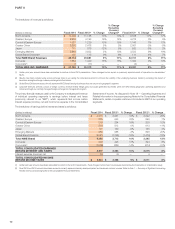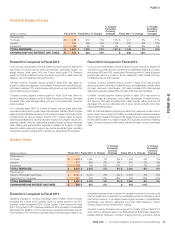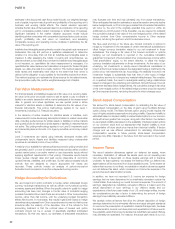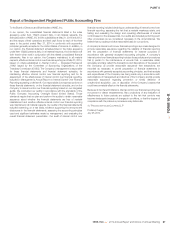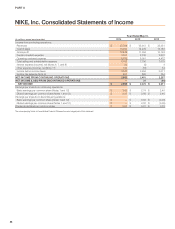Nike 2014 Annual Report Download - page 37
Download and view the complete annual report
Please find page 37 of the 2014 Nike annual report below. You can navigate through the pages in the report by either clicking on the pages listed below, or by using the keyword search tool below to find specific information within the annual report.
PART II
The total liability for uncertain tax positions was $506 million, excluding related interest and penalties, at May 31, 2014. We are not able to reasonably estimate
when or if cash payments of the long-term liability for uncertain tax positions will occur.
We also have the following outstanding short-term debt obligations as of May 31, 2014. Refer to Note 7 — Short-Term Borrowings and Credit Lines in the
accompanying Notes to the Consolidated Financial Statements for further description and interest rates related to the short-term debt obligations listed below.
(In millions)
Outstanding as
of May 31, 2014
Notes payable, due at mutually agreed-upon dates within one year of issuance or on demand $ 167
Payable to Sojitz America for the purchase of inventories, generally due 60 days after shipment of goods from a foreign port 60
As of May 31, 2014, letters of credit of $135 million were outstanding, which were generally issued for the purchase of inventory and as guarantees of the
Company’s performance under certain self-insurance and other programs.
Recently Adopted Accounting Standards
In July 2013, the Financial Accounting Standards Board (“FASB”) issued an
accounting standards update intended to provide guidance on the
presentation of unrecognized tax benefits, reflecting the manner in which an
entity would settle, at the reporting date, any additional income taxes that
would result from the disallowance of a tax position when net operating loss
carryforwards, similar tax losses, or tax credit carryforwards exist. This
accounting standard is effective for us beginning June 1, 2014 and early
adoption is permitted. We early adopted this guidance and the adoption did
not have a material impact on our consolidated financial position or results of
operations.
In July 2012, the FASB issued an accounting standards update intended to
simplify how an entity tests indefinite-lived intangible assets other than
goodwill for impairment by providing entities with an option to perform a
qualitative assessment to determine whether further impairment testing is
necessary. This accounting standard update was effective for us beginning
June 1, 2013. The adoption of this standard did not have a material impact on
our consolidated financial position or results of operations.
In December 2011, the FASB issued guidance enhancing disclosure
requirements surrounding the nature of an entity’s right to offset and related
arrangements associated with its financial instruments and derivative
instruments. This new guidance requires companies to disclose both gross
and net information about instruments and transactions eligible for offset in
the statement of financial position and instruments and transactions subject
to master netting arrangements. This new guidance was effective for us
beginning June 1, 2013. As this guidance only requires expanded
disclosures, the adoption had no impact on our consolidated financial
position or results of operations.
Recently Issued Accounting Standards
In May 2014, the FASB issued an accounting standards update that replaces
existing revenue recognition guidance. Among other things, the updated
guidance requires companies to recognize revenue in a way that depicts the
transfer of promised goods or services to customers in an amount that
reflects the consideration to which the entity expects to be entitled in
exchange for those goods or services. The new guidance is effective for the
Company beginning June 1, 2017. We are currently evaluating the effect the
guidance will have on the Company’s consolidated financial position or results
of operations.
Critical Accounting Policies
Our previous discussion and analysis of our financial condition and results of
operations are based upon our consolidated financial statements, which have
been prepared in accordance with accounting principles generally accepted
in the United States of America. The preparation of these financial statements
requires us to make estimates and judgments that affect the reported
amounts of assets, liabilities, revenues and expenses, and related disclosure
of contingent assets and liabilities.
We believe that the estimates, assumptions, and judgments involved in the
accounting policies described below have the greatest potential impact on
our financial statements, so we consider these to be our critical accounting
policies. Because of the uncertainty inherent in these matters, actual results
could differ from the estimates we use in applying the critical accounting
policies. Certain of these critical accounting policies affect working capital
account balances, including the policies for revenue recognition, the
allowance for uncollectible accounts receivable, inventory reserves, and
contingent payments under endorsement contracts. These policies require
that we make estimates in the preparation of our financial statements as of a
given date. However, since our business cycle is relatively short, actual results
related to these estimates are generally known within the six-month period
following the financial statement date. Thus, these policies generally affect
only the timing of reported amounts across two to three fiscal quarters.
Within the context of these critical accounting policies, we are not currently
aware of any reasonably likely events or circumstances that would result in
materially different amounts being reported.
Revenue Recognition
We record wholesale revenues when title passes and the risks and rewards of
ownership have passed to the customer, based on the terms of sale. Title
passes generally upon shipment or upon receipt by the customer depending
on the country of the sale and the agreement with the customer. Retail store
revenues are recorded at the time of sale.
In some instances, we ship product directly from our supplier to the customer
and recognize revenue when the product is delivered to and accepted by the
customer. Our revenues may fluctuate in cases when our customers delay
accepting shipment of product for periods of up to several weeks.
In certain countries outside of the United States, precise information regarding
the date of receipt by the customer is not readily available. In these cases, we
estimate the date of receipt by the customer based upon historical delivery
times by geographic location. On the basis of our tests of actual transactions,
we have no indication that these estimates have been materially inaccurate
historically.
80


